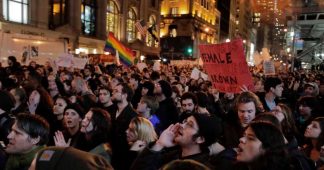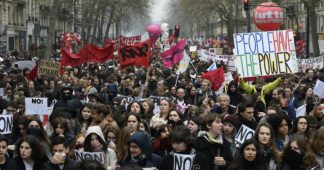By Patrick Martin
Several hundred thousand people took part in demonstrations worldwide in support of the March for Science held in Washington, DC Saturday. The protests were organized in response to efforts by the new Trump administration to suppress scientific inquiry, particularly in the area of climate change, and to slash spending on a wide array of scientific research, from global warming to cures for diseases.
Tens of thousands participated in protests on April 22 that began with the new day in New Zealand and across Australia, and continued in Asia, Europe, Latin America and at hundreds of locations across the United States. There were protests on every inhabited continent and even in Antarctica, where research scientists posted statements of support on the Internet.
The rally in Washington DC
By far the main turnout for the protests was in the United States. The largest demonstration, in a steady rain, brought about 75,000 people to Washington, DC, where they rallied on the Washington Monument grounds, within sight of the White House, listened to speeches by scientists and environmental activists for several hours, then marched down Constitution Avenue to the US Capitol.
Over 50,000 people marched in Chicago. The demonstration snaked its way through the city’s Grant Park downtown, ending outside the Field Museum of Natural History, where a science expo took place.
College and high school students, teachers, scientists, professionals and entire families travelled from throughout Illinois and surrounding states, some hundreds of miles, to join the demonstration. Many held signs and chanted slogans defending science, reason and social progress. Others were overtly political, denouncing war and the corporate destruction of the environment, or calling for the resignation of President Donald Trump.
A section of the March in New York City
In New York City, some 30,000 people marched up Broadway, passing the Trump International Hotel and Tower near Central Park, where they began chanting demands for Trump’s ouster from the White House. There were numerous scientists wearing white lab coats, and speakers denounced cuts in the National Institutes of Health and the Environmental Protection Agency.
Several thousand people from the Boston area and throughout New England gathered on the Boston Common. Scientists, researchers and students from Harvard, MIT, Massachusetts General Hospital and the Dana-Farber Cancer Institute, and from many other schools and institutions, voiced their support for science in the face of climate change denial and proposed federal budget cuts.
The march in San Francisco
There were large demonstrations in major California cities, with 15,000 to 20,000 turning out in San Diego, Los Angeles, San Francisco and Sacramento, and dozens of smaller marches held throughout the state.
Virtually every major American city saw a sizeable demonstration, as well as most university and college towns, including some as small as Valdosta, Georgia, population 56,000, home to Valdosta State University.
Members of the Socialist Equality Party and other supporters of the World Socialist Web Site attended the main demonstration in Washington, DC, where they distributed thousands of copies of the WSWS perspective “Science and Socialism,” explaining the SEP’s policy of waging a political defense of science through the mobilization of the working class against both the Trump administration and the Democratic Party, and against the capitalist system as a whole.
The march in DC
At many of the rallies, a sharp difference was evident between the speeches delivered, generally of a well-meaning, pro-science character, but lacking any political thrust, and the sentiments of many of those attending, who were extremely hostile to Trump and receptive to the call made in the SEP statement for a political struggle against capitalism and war.
This was the case at the main rally in Washington, where speeches were delivered by scientists who have carried out distinguished acts of public service, like Dr. Mona Hanna-Attisha, who helped expose the lead poisoning of children in Flint, Michigan by the criminal mismanagement of the water supply by the city and state government, and by well-known advocates of scientific education, like Bill Nye, the former host of the PBS children’s science program.
While the speakers made occasional references to Trump, with the White House visible from the platform, there was no perspective presented on how Trump’s policies could be opposed, still less on what social force such opposition should be based. The implication—expressed most obviously in marching down Constitution Avenue to the US Capitol—was to make an appeal to Congress and the Democratic Party to restrain the worst decisions and cuts made by the Trump administration.
Many of those who marched in the Washington demonstration, however, were in no doubt that everything possible had to be done to build a political movement against Trump, and they discussed the SEP’s critique of the Democratic Party as the second party of American big business, equally responsible with Trump and the Republicans for the program of imperialist war, attacks on democratic rights and cuts in social spending.
Frank, a high school student from Washington, DC, told the WSWS, “I came here today to show that even though the Trump administration doesn’t care about what happens to everyday Americans, they’re totally fine with dumping coal dust in rivers, bringing coal back, bringing smog back to our cities.
He continued, “There’s always money for war, but there’s never money for science, there’s never money for education, there’s never money for health care—it’s never anything that goes to help the common people. It’s just something so that we can go shoot missiles at a military base in Syria. That attack cost hundreds of millions of dollars, an utter waste …”
“America’s two-party system and the way our parties stand today, is very pro-war,” he said. “It would have to have a complete turnover of people in the parties or the destruction of the two-party system to bring around a multi-party system where there could be a party that supports the people.”
Steven King, a retired typographer and former union member, said, “I’m here today because the march for science is important. The social sciences are just as important as the physical sciences. Right now, the oligarchy is cherry-picking the social sciences so that they can deny the need for psychology and positive-community sociology. They manipulate all of the social sciences, that’s going to manipulate people towards the worst ends like war.”
Asked what he thought the underlying causes of the attack on science were, he replied, “Your ignorance can be manipulated more than your intelligence. And the destruction of education is part of that. And so people don’t question, from religious beliefs to your leaders becoming almost like gods. It’s ridiculous—that bazillionaires are like gods. It’s ridiculous.”
Brooke Waligora and Sarah Phillips, two nurses from Michigan, spoke on why they travelled to the rally in Washington.
Brooke said, “We are here to let people know that research saves people’s lives. The things we do every day to treat people are all based on science. We are constantly learning so that we can treat people better.”
Sarah explained, “All the procedures that we do are procedures that were developed by scientific research, and this needs to be continued and expanded. I myself had leukemia, and I was part of a research treatment. Because of that research, that treatment is now the standard that is used to treat leukemia.
“I am also here against the cutting of health care. Every day we treat people who don’t know how they are going to buy their medicines. Health care is a right which everyone should have.”
In contrast to the national rally, where Democratic politicians were barred from the platform, they were able to speak at a number of the regional marches, including Boston, Los Angeles, San Diego, and Lansing, Michigan. They frequently sought to turn the protests in a right-wing nationalist direction.
Part of the protest in Boston
In Boston, Obama’s former EPA Director Gina McCarthy was a major speaker. She claimed that Trump “could roll back progress on our air and water quality” allegedly made under the Obama administration. The truth is that the Obama administration blocked any significant action on climate change and delayed many pollution rules to the point that they are now subject to repeal by the Republican-controlled Congress
In Los Angeles, billionaire Tom Steyer, the biggest donor to Democratic candidates in 2014 and a likely candidate for governor of California next year, was one of the main speakers. He advocated a form of “California First” that sounded much like a slightly more environmentally-friendly version of Trump’s “America First.” He boasted that California was the national and global leader in research, technology and innovation, and would remain so, regardless of the policies that “come out of Washington, DC.”
Even more reactionary were the speeches delivered in San Diego, where Democratic Congressman Scott Peters declared that the US military was “doing some of the most important work in renewable energy,” and that the Navy “is going green,” and that this was a “patriotic duty,” because it reduced American reliance on foreign-imported energy.
Alongside Peters was Ralph Keeling, Director of the Scripps CO2 program at the University of California, San Diego, who launched into a nationalist tirade, stating that unless the United States takes the lead in environmental research and solutions, “other countries will tell us how to deal with climate change.”
He asked, “Do we want the Chinese to fix our problems?” in a scornful tone, but the question did not get the expected response of outrage from the crowd. Keeling went on to state his concern that “our military bases” are affected by environmental problems, referring to these as a “national security concern.”











